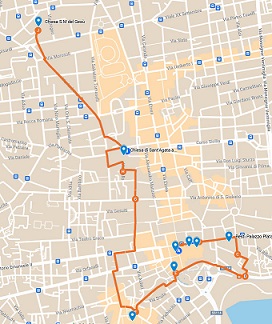
The following route connects the monuments and the testimonies that document the history of Catania in the centuries that preceded the terrible earthquake of 1693.
Start of the tour in Piazza Duomo. Duomo (1) (transept, sarcophagus of Constance of Aragon, chapel of S. Agata etc...); entrance piazza Duomo; poster inside the Duomo. Duomo (1), fresco with the eruption of 1669; entrance to the sacristy of the Duomo billboard inside the sacristy. Seminary of the Clerics (10); poster in the sacristy.
Next path: via V. Emanuele. In via V. Emanuele apses of the Duomo entrance via V. Emanuele 159.
Next path: piazza S. Placido, via Landolina. In via Landolina remains of the ancient palace of Platamon (11) in via Landolina 11; billboard at the entrance.
Next route that will allow you to admire the sixteenth-century walls: via Museo Biscari, piazza Duca di Genova, via Cardinale Dusmet, piazza Pardo. In Piazza Pardo, door of Charles V (12) billboard inside the Seminary of Clerics (10).
Next path: via S. Calogero (with stalls of the fish market), piazza Federico di Svevia. In Piazza Federico di Svevia, the Castello Ursino (13); billboard inside the Castle.
Next path: via Castello Usino, via Garibaldi, via S. Anna, via V. Emanuele, piazza S. Francesco d'Assisi, via Crociferi, via Cerami, via Gallo, via Jacona, via S. Maddalena, via Garofalo, piazza Santo Carcere. In Piazza Santo Carcere, church of S. Agata al Carcere (14) with Romanesque portal; poster inside the church.
Next path: via Cappuccini, piazza S. Domenico, via Androne, piazza S. Maria di Gesù. In piazza S.M. di Gesù Church of S.M. di Gesù (15).
- Dome
- Seminario dei Chierici
- Palazzo Platamone
- Porta Carlo V
- Castello Ursino
- Chiesa di S. Agata al Carcere
- Chiesa di S. Maria di Gesù